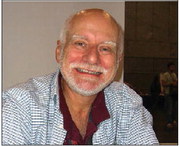‘The audience still loves the work I did and that’s cool’

‘The audience still loves the work I did and that’s cool’
A conversation with iconic ‘ X- Men’ writer Chris Claremont
news@theeveningtimes.com
Karma dragged Chris Claremont to embrace a bunch of mutant superheroes the minute he walked in the door of Marvel Comics back in 1969.
The British-born comic book writer didn’t start out looking to work in the comic book industry, but he would go on to be the writer of X-Men from 1975-1991 — longer than any other writer on a single title in comic book history. X-Men became one of the best selling comic titles of all time during his stint on the book.
“I jumped on the bandwagon of X-Men unwittingly from the moment I walked into the door,” Claremont said. “I got the opportunity to write really cool stories and create wonderful characters for a quarter century. For me as a creator, what I love is the audience still loves the work I did and that’s cool.
After 40 years that’s wonderful.”
Claremont was one of the featured guests of comic book artists and writers this weekend at the Memphis Comic Expo at the Agricenter International. Claremont will join other industry legends like artist Mike Grell (Green Lantern, Green Arrow), Larry Hama (writer G.I. Joe: A Real American Hero), artist Jae Lee, and writer and artists Mike Curtis and Joe Staton (Dick Tracy).
Claremont started out as a gofer at Marvel but his arrival coincided with the beginning of a popular run on X-Men by Roy Thomas and Neal Adams.
“I was the young punk in the office,” Claremont said. “Gofer this, gofer that. Anything that was scut work ended up on my lap. Nowadays they are known more respectfully as interns.”
Claremont got his first plot credit for X-Men #59 when he suggested a way for writer Roy Thomas to wrap up the Sentinels story line. The Sentinels are mutant hunting robots who were antagonists of the x-Men.
“Roy had painted the XMen into a box with the Sentinels,” Claremont said. “He had to figure a way to get rid of them. So, not knowing any better, I just shot off my mouth. I said well, if you are looking for a way to eliminates mutants the scientific thought at the time was that mutations are triggered by solar radiation. If you want to get rid of radiation, get rid of the sun.”
The next thing he knew, the Sentinels were seen flying into the sun.
“It gave Neal Adams the chance to draw one of the most spectacular pages I’ve ever seen,” Claremont said. I”t was a full page of the sun with the Sentinels disappearing into the middle of it.”
Claremont’s first break at Marvel came when he was given a fledgling Iron Fist character in Marvel Premiere No. 23 and paired with a young artist, John Byrne, who he would later enjoy a long collaboration with on X-Men.
“It was a lot of fun,” Claremont said. “It was my first superhero series and it coincided with the arrival of John Byrne as an artist.
It was a joy to watch him blossom into an extraordinary talent and to work with.”
In 1974, Marvel editor-inchief Len Wein and Dave Cockrum were working on Giant-Size X-Men #1 and were trying to figure out a way to get rid of the island of Krakoa. In the story, the original X-Men disappear on a mission to Krakoa and a new team of X-Men is sent looking for them.
Claremont gave them the idea to destroy the island by shooting it in to outerspace.
“I just threw out an idea that just popped into my head to have the X-Men use their powers to sever the island,” Claremont said. “They basically just sliced the island free of its bedrock and let the motion of the sun and Earth do the rest. Poof! Krakoa goes blissfully sailing into space.”
Wein recognized Claremont’s love for the X-Men and hired him to take over the book in 1975. “For various reasons, Len decided he didn’t have enough time in his schedule to handle X-Men so he said ‘who wants this book?’ X-Men wasn’t the big seller that it became yet. Before he could, I just tackled him and said ‘I want it. Don’t give it to anybody else. I want it.’ And he was kind enough to say okay.”
Over the next 17 years, Claremont wrote or cowrote many classic stories like “The Dark Phoenix Saga” and “Days of Future Past” and X-Men became a top seller for Marvel. He also co-created numerous characters like Rogue, Phoenix, Mystique, Emma Frost, Madelyne Pryor, Pyro and Sabertooth.
“I got the ridiculous good fortune of working with one of the finest story tellers and one of the best creators of characters this industry has ever seen in Dave Cockrum,” Claremont said. “I got to work with him on a whole bunch of really cool, brand new characters that had just been created. So I got to literally explore virgin territory from that point on. That’s a gift that can’t happen any more because it’s all established today.”
Claremont was known for developing strong female characters.
“I felt the book needed to have a strong balance of women,” Claremont said.
“Why? Because 51 percent of the population are women. The thing about X-Men is in its heyday we had 100,000 to 130,000 plus girls reading the book. No other book could say that.”
Claremont and Byrne also developed the character Wolverine into a fan favorite.
“Dave was never cool about Wolverine,” Claremont said. “He didn’t create Logan so he didn’t have that much affection for him. The character he loved was Nightcrawler.
He always got the best lines.”
Claremont said Cockrum is the one, however, who changed Wolverine from a character who had claws in his gloves , to having adamantium claws embedded in his actual skeleton, which made him more mysterious.
“I thought that was cool,” Claremont said. “What kind of a man has adamantium claws implanted into his body? That set up the whole foundation of Wolverine.”
It was John Byrne, Claremont said, who really brought Wolverine into his own.
“John loved him,” Claremont said.
“Wolverine was Canadian.
John was Canadian. And his perspective about Wolverine matched with mine so we just ran with it.”
Claremont said he loves Wolverine because he is such a private soul.
“He will not volunteer anything,” Claremont said.
“With Logan, to me, it’s none of your damn business. He is such a private man. What I loved about him was the mystery.
You’re always aware that there are secrets within him.”
Wolverine would go on to have his own best-selling spin-off series in 1991 and whose No.1 issue co-written by Claremont remains the best selling comic of all time.
Claremont said while there is some good work being done in comics today, he doesn’t read comics anymore because he finds them uninteresting.
“I go out of my way not to read X-Men because if I’m not writing it, I’m not interested,” Claremont said. “It’s not a pleasure any more because I don’t know the characters and I’m not altogether sure I am comfortable with the direction the current writers and editors are taking it.”
Claremont said it is unlikely that any comic book writer will ever again spend 17 years in charge of one book like he did. In fact, his advice to writers and artists today is to have as much fun as they can during their run and then move on to something new. He much prefers working on his own original creations as opposed to ones owned by Marvel.
“The cruel reality of the comic book industry is writers and artists are all transients,” Claremont said. “The trick is to have fun and make it meaningful and as exciting and ideally as irresistible for audiences as you can. But when the final curtain falls, move the heck on and find something better and make people forget what you did before and embrace it even more.”
Claremont said he enjoys going to comic conventions and meeting fans and is very appreciative that they still remember and like his work.
“It is a great way to interact with readers and see what is cool in their eyes,” Claremont said.
“The fact that these stories reached out and touched people and affected them, it is a daunting and humbling experience because it carries with it a great responsibility. If something has that much effect, you can’t screw it up. One of the things I loved about XMen was every issue we had half a million readers. That is an audience you don’t want to fool with.”


By Mark Randall


Share